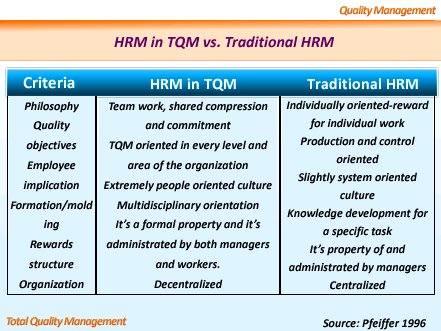Human Resources Management in Total Quality
Human Resources Management in TQM.

Human resources management aspects are increased by updating from a culture to quality management philosophies and techniques. In the image above, you can see the 12 main differences between a traditional Human Resources Management (HRM) and a Total Quality oriented HRM.
Traditional (HRM) against a Total Quality oriented HRM
In this lesson, we will determine what human resources management practices and policies we must adopt to enhance TQM.
Selecting Human Resources.
Qualities can aid TQM. During the selection process, TQM objectives must guide the search for the types of qualities needed from the employee. If TQM points out team work, factors such as team work orientation, interpersonal abilities, or the capability to get along with others, could be decisive. Another ability to consider would be the ability to solve problems effectively.
Evaluation and retribution through merits.
There must be a change in the way we evaluate workers in a TQM system against the traditionally used methods. Managers and supervisors must identify which factors belong to the employee and which belong to the system, identifying their variables.
Employee molding and developing.
Molding and developing is a requirement for a quality-oriented organization. A great portion of traditional molding is related to staff support in the technology of chain of production and processes. Molding to create work teams or quality circles may be an interesting road for TQM formation. This implies increasing the knowledge of employees.
According to James (1997) quality forming must include human aspects (equipment construction, culture, communication), technicians (benchmarking and abilities for method improvement, and problem solving), and leadership (change management, direction and consulting).